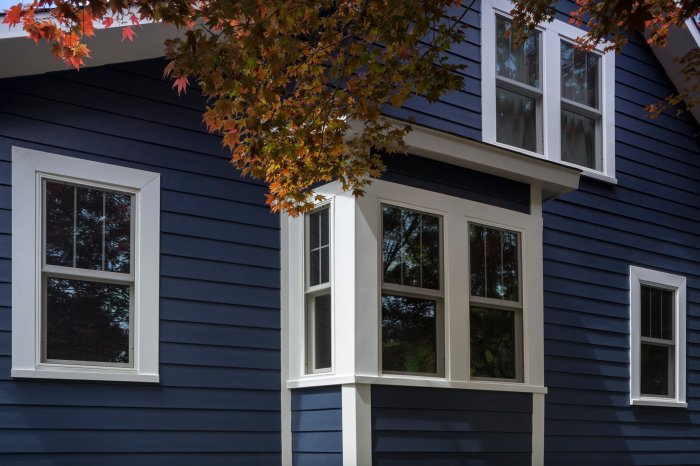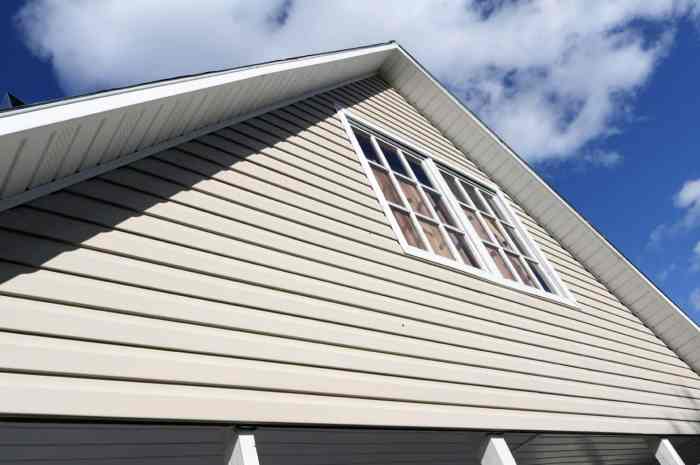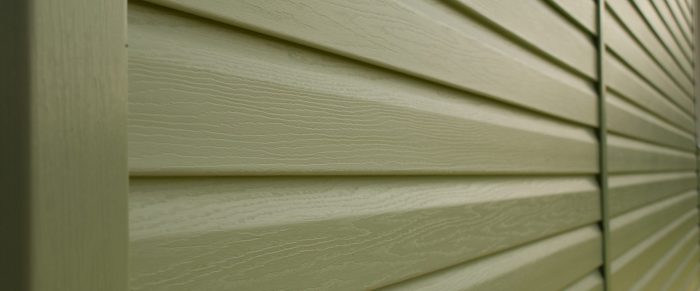Long-lasting Insulated Siding: A Homeowners Guide – Long-lasting Insulated Siding: A Homeowner’s Guide – Thinking about upgrading your home’s exterior? Insulated siding offers a blend of durability, energy efficiency, and aesthetic appeal that can significantly enhance your property’s value and comfort. This guide dives deep into the world of long-lasting insulated siding, exploring various materials, installation processes, cost considerations, and the overall impact on your home’s energy consumption and curb appeal.
Get ready to transform your house into a stylish and energy-efficient haven!
From understanding the different types of materials available – vinyl, fiber cement, engineered wood – to navigating the installation process and choosing the right contractor, we’ll equip you with the knowledge to make informed decisions. We’ll also explore the long-term cost savings associated with improved insulation, and how choosing the right siding can significantly reduce your energy bills. This isn’t just about siding; it’s about investing in your home’s future.
Introduction to Long-Lasting Insulated Siding: Long-lasting Insulated Siding: A Homeowners Guide

Choosing the right siding for your home is a significant investment, impacting both its aesthetic appeal and long-term durability. Long-lasting insulated siding offers a compelling solution, combining attractive exterior finishes with superior energy efficiency. This guide will explore the benefits and considerations involved in selecting this increasingly popular option for homeowners.Insulated siding, while a relatively modern building material in its current form, boasts a history rooted in the ongoing quest for better home insulation and more attractive exteriors.
Early iterations focused primarily on improving thermal performance, often using materials like fiberboard or foam sheathing covered with a less durable outer layer. However, technological advancements have led to the development of durable, aesthetically pleasing composite materials, incorporating insulation directly into the siding panels. This evolution has resulted in a product that offers both superior energy efficiency and longevity, making it a cost-effective choice in the long run.
Benefits of Long-Lasting Insulated Siding for Homeowners
Three key reasons stand out when considering long-lasting insulated siding. First, its inherent insulation properties significantly reduce energy consumption. This translates to lower heating and cooling bills, a considerable financial benefit over the lifespan of the siding. Second, the durable construction of modern insulated siding means it requires less maintenance compared to traditional options like wood or vinyl. This reduced maintenance translates to lower long-term costs and less hassle for homeowners.
Finally, the wide variety of styles, colors, and textures available allows homeowners to customize their home’s exterior to match their personal preferences and architectural style, enhancing curb appeal and property value.
Installation and Maintenance of Insulated Siding

Choosing and installing long-lasting insulated siding is a significant investment in your home’s comfort and curb appeal. Proper installation ensures optimal performance and longevity, while regular maintenance prevents costly repairs down the line. This section details the installation process and provides a comprehensive maintenance checklist.
Insulated Siding Installation: A Step-by-Step Guide, Long-lasting Insulated Siding: A Homeowners Guide
Successful insulated siding installation hinges on meticulous preparation and careful execution. A poorly installed system can lead to issues such as water leakage, compromised insulation, and premature deterioration. The following steps Artikel a typical installation process. Note that specific procedures may vary slightly depending on the siding type and manufacturer’s instructions.
- Preparation: Begin by thoroughly cleaning the existing exterior walls, removing any loose paint, debris, or old siding. Inspect the underlying sheathing for damage and repair as needed. This foundational step is crucial for a secure and long-lasting installation.
- Framing and Furring Strips (If Necessary): Depending on the wall’s condition and the siding system, furring strips might be required to create a level surface and maintain the necessary air gap for ventilation. Properly spaced furring strips ensure even siding application and prevent moisture buildup.
- Installation of Starter Strips: Install starter strips along the bottom of the wall, ensuring they are level and plumb. These strips provide a solid base for the first row of siding panels. Accurate placement here prevents alignment issues further up the wall.
- Panel Installation: Install the insulated siding panels, starting from the bottom and working your way up. Each panel should be interlocked securely with the previous one, ensuring a tight and weatherproof seal. Follow the manufacturer’s instructions for proper overlapping and fastening.
- Flashing and Caulking: Apply flashing around windows, doors, and other openings to prevent water penetration. Use high-quality caulk to seal any gaps or joints between panels and around accessories. Thorough caulking prevents water intrusion and enhances the system’s weather resistance.
- Finishing: Install trim, corner pieces, and other accessories according to the manufacturer’s specifications. Ensure all components are properly secured and aligned for a professional finish. Paying close attention to detail in this phase completes the aesthetic appeal.
Potential Installation Challenges and Solutions
Several challenges can arise during insulated siding installation. Addressing these proactively minimizes potential problems and ensures a successful outcome.
- Uneven Walls: Uneven walls require extra attention during preparation. Utilizing furring strips or shims helps create a level surface for consistent siding application. Failure to address unevenness can lead to gaps and poor aesthetics.
- Difficult Weather Conditions: Extreme heat or cold can impact the installation process. Work in favorable weather conditions whenever possible. Extreme temperatures can affect adhesive properties and panel flexibility.
- Improper Panel Alignment: Careful measurement and precise cutting are crucial to avoid misalignment. Using a level and plumb bob throughout the installation process helps maintain consistent alignment and avoids costly rework.
Insulated Siding Maintenance Checklist
Regular maintenance is key to extending the lifespan of your insulated siding. This checklist Artikels essential maintenance tasks.
- Annual Inspection: Conduct a thorough visual inspection of the siding at least once a year, checking for damage, loose panels, or signs of water intrusion. Early detection of problems allows for timely and cost-effective repairs.
- Cleaning: Clean the siding periodically using a soft brush, mild detergent, and water. Avoid harsh chemicals or abrasive cleaners, which can damage the siding’s surface. Regular cleaning removes dirt and grime, maintaining the siding’s appearance and protecting it from damage.
- Caulk Inspection and Repair: Inspect caulking around windows, doors, and other openings for cracks or gaps. Repair or replace any damaged caulking promptly to prevent water leakage. This prevents water from penetrating the wall system.
- Repair Damaged Panels: Repair or replace any damaged or loose panels as needed. Prompt repair prevents further damage and maintains the siding’s structural integrity. Ignoring damage can lead to extensive and costly repairs later.
Array
Choosing the right insulated siding isn’t just about durability and energy efficiency; it’s also about enhancing your home’s curb appeal and reflecting your personal style. The variety of colors, textures, and styles available allows for a truly customized look, transforming your house into a home that reflects your unique taste. Let’s explore how you can leverage these options to create a stunning exterior.
The beauty of long-lasting insulated siding lies in its versatility. It can seamlessly complement various architectural styles, from traditional to modern, creating a cohesive and visually appealing façade. The right choice can dramatically improve your home’s value and overall aesthetic impact.
Siding Options and Architectural Styles
Different siding materials and finishes can dramatically alter the perceived style of a home. A careful selection process, considering both the material and the color palette, is key to achieving the desired aesthetic. For instance, a rustic home might benefit from the warmth of natural wood-look vinyl siding, while a modern home might look sleek with smooth, flat panels in a contemporary color.
Examples of Siding Choices for Different House Styles
Let’s visualize three distinct house styles and explore appropriate siding choices:
1. Traditional Colonial: Imagine a classic two-story colonial with symmetrical windows and a gabled roof. For this style, a clapboard-style vinyl siding in a warm, earthy tone like a deep cream or soft beige would be ideal. The subtle texture of the clapboard mimics the traditional wood siding while offering superior durability and low maintenance. Consider adding darker brown or black accents around windows and doors to highlight architectural details.
The overall effect would be elegant and timeless, respecting the home’s heritage.
2. Modern Farmhouse: Picture a single-story home with a large, inviting porch, clean lines, and large windows. For this style, a horizontal plank-style fiber cement siding in a light gray or charcoal gray would be a striking choice. The clean lines of the siding complement the home’s modern aesthetic, while the subtle texture adds a touch of rustic charm.
Consider using a contrasting darker gray or black for the trim around the windows and doors to create a sharp, modern look. The overall impression is one of sophisticated simplicity and understated elegance.
3. Contemporary Ranch: Visualize a low-slung ranch-style home with a flat roof and expansive windows. For this style, a smooth, flat panel siding in a bold color like a deep navy blue or a vibrant red would make a statement. The sleek, modern look of the siding complements the home’s architectural style, while the bold color adds personality and visual interest.
Consider using lighter-colored trim to contrast with the siding and highlight the home’s clean lines. The overall feel is one of confident modernity and eye-catching design.
Ultimately, choosing long-lasting insulated siding is an investment that pays off in multiple ways. From enhanced curb appeal and increased home value to significant energy savings and reduced environmental impact, the benefits are undeniable. By understanding the various materials, installation processes, and cost factors involved, homeowners can confidently make informed decisions that align with their budget and aesthetic preferences.
So, are you ready to upgrade your home’s exterior and enjoy the many advantages of long-lasting insulated siding?
Quick FAQs
What is the average lifespan of insulated vinyl siding?
Insulated vinyl siding typically lasts 30-50 years, depending on the quality and proper maintenance.
Can I install insulated siding myself?
While possible for some DIY enthusiasts, professional installation is highly recommended for optimal results and warranty coverage. The process is more complex than standard siding.
How does insulated siding affect my home insurance?
Insulated siding can potentially lower your home insurance premiums due to its improved fire resistance and overall home protection.
What about the warranty on insulated siding?
Warranties vary depending on the manufacturer and material. Always check the warranty details before purchasing.
Is insulated siding suitable for all climates?
Yes, various insulated siding options are designed to withstand different climates and weather conditions. Choosing the right material is crucial for your specific location.